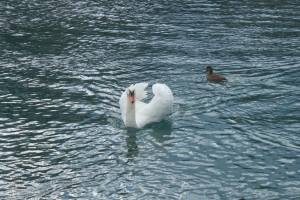It is easily identifiable as it has a wingspan of nearly 2 metres. The bill is orange with a black knob, which is larger in the male in the spring. It is omnivore and always in search of food, dipping the long neck underwater rummaging in the mud of the bottom in search of molluscs, crustaceans, leaves and shoots.
It is also known as 'royal' swan as the hunt of this species was a prerogative of kings in the past.
Couples form at the end of autumn and remain tied for life. Nesting occurs in the spring. The nest has a diameter basis of between 2 and 4 metres and is made up of roots, fragments of reeds and rushes while the upper part has finer and softer materials. It is usually built close to the shore in a place well protected by the vegetation or in the water as to be protected from predators. The female lays 5 to 8 eggs with a greyish shell. After about 35 days the chicks hatch, covered in grey down and often go up the adult's back to rest. Sexual maturity is reached at the third year of life.
The flight, taken after a long ride on the water due to the large size (the weight of an adult swan varies from 10 to 20 Kg), is rectilinear; the neck is kept outstretched, while the wings produce a typical metallic hiss.
Bibliography
Svensson L., Mullarney K. & Zetterstrom D., 2013 - Guida degli uccelli d'Europa Nord Africa e Vicino Oriente. Ricca Editore.
Saporetti F. & Carabella M., 2012 – Uccelli Acquatici Svernanti – 25 anni di dati in Provincia di Varese. Quaderno 1 del Gruppo Insubrico di Ornitologia. Provincia di Varese, Settore Politiche per l'Agricoltura e Gestione Faunistica e LIPU.
Aletti R. & Carabella M., 2015 – Check-list degli Uccelli della Provincia di Varese – Lista completa commentata e illustrata. Quaderno 2 del Gruppo Insubrico di Ornitologia.
Fotografie: Isella Bellotti


